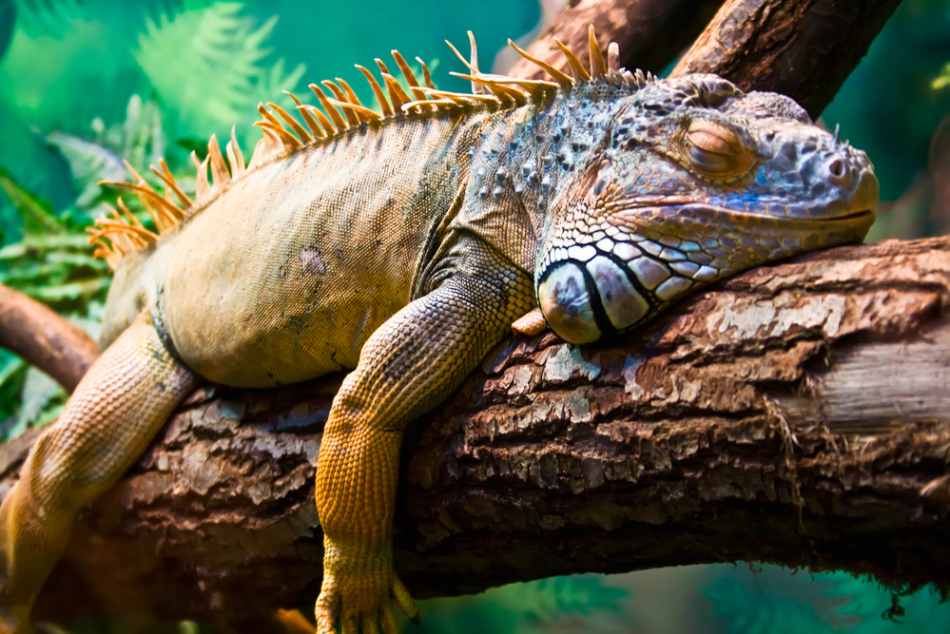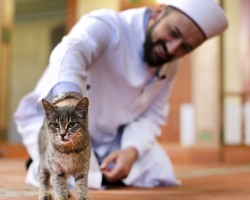Iguana, like a chameleon, is considered the most common house lizard. It is made by lovers of exotic animals who are not impressive by traditional pets - cats and dogs.
Content
- What does Iguan look like?
- Types of iguan
- Where does Iguan live?
- What do the Iguans eat?
- Iguana at home: can you hold, is it dangerous?
- Iguana: maintenance at home
- Iguana: home care
- How many Iguans live?
- The price of the iguana
- Iguan content in the apartment: reviews
- Video: Iguana at home. How to contain iguan at home?
Iguan is a simple beautiful reptile, pleasing to the eye, it does not catch any insects, as the chameleon does, so it does not benefit. Iguan has its own habits, but what does this animal eat? Where does he live, how to care for a pet at home and is not dangerous? Read about this below.
What does Iguan look like?
- Iguana - This is a large lizard. The body length of the animal is approximately 2 m. The average weight is 7 kg. But in nature, you can find representatives of this species much less, for example, Blue Iguan. The lizard is covered with thorns, the length of its body is no more than 30 cm.

- Iguana, like the rest of the lizards, is covered with scales. Scales itself, depending on the type of reptile, can be different sizes, colors.
- The animal has the ability to change its own color, but does it not as easy as chameleon. The shade of the pet depends on what temperature it lives. If around is cool, the skin of the reptile becomes dark, but if hot - bright.
- A variety of types of lizards have their own color. As a rule, the color of the iguana is created so that it can merge as much as possible with the environment. For example, Iguan, who lives in the jungle, is green.
- A characteristic feature of Iguana - she has a thorny crest, located on the spine. This crest decorates the appearance of the pet, plus protects it.
- Iguana has a thin ridge, a rather flexible body that is flattened on the sides. It is thanks to this structure that the animal will quickly fly even in narrow cracks.
- The lizard has large tailwhich is much more than the body. It is muscular, helps reptiles while driving. If Iguan threatens something, she discards her own tail, which after a while grows again.
- There are sharp claws on the paws of the iguana. They are necessary for self -defense. With the help of them, the animal can also mix through various irregularities, climb into the trees, if necessary.

- The lizards resemble human structure, they can also regenerate if they fall out.
- Iguana's tongue Distinguishes tastes, as well as aromas. Sometimes he replaces his nose. Therefore, the reptile has an excellent sense of smell, oriented in the world of aromas.
- The eyes of Iguana They see even when closed. This is because the lower eyelids have a special recess, which does not allow the eyes to close 100%. That is, the lizard is physically not able to completely close her eyes. Such a structure of the eyes sometimes helps iguan during self -defense.
Types of iguan
In nature, you can count approximately 40 types of iguan. The most common are the following:
- Ordinary iguana. It is considered the largest, known. He lives on the territory of Central and South America. It can be a maximum of 1 m 50 cm long, weighing no more than 4 kg. The color of the lizard is different. It all depends on exactly where the pet lives. On the back of the iguana is a comb. In the area of \u200b\u200bthe chin there is a bag necessary for thermoregulation. It also helps the lizard attract the opposite sex during the wedding period.

- Black Iguan. The reptile lives on the territory of Mexico, in rocky areas. The maximum length is 1 m 40 cm. The iguan has, at the same time, a short head. On the back of the lizard there is a comb that turns to the tail. It contains spikes designed for self -defense. Eating iguana flowers, fruits, foliage.

- Madagascar Iguana. It grows in length a maximum of 30 cm, but sometimes individuals are found a little more. The color of the lizard is dark brown, spots and strips are present on the body. There is a bright scallop on the male's head. The lizard lives in the sand dunes of the island of Madagascar. It feeds mainly with plants and small insects.

- Blue Iguan. It is considered a rare appearance, the habitat is the island of Big Kayman. The lizard prefers to live on the sea coast, she also likes open areas, rocks, dry forests. The length of the iguana is a maximum of 1 m 50 cm.
- Striped Fiji Iguan. A small reptile, the length of which is no more than 1 m. The color of the iguana is bright green. There are wide light strips along the whole body. When the reptile is aggressive, or during the wedding period, the male Iguana becomes black.

- Desert iguana. The tail of this iguana is 40 cm, the animal has a dense body. The color of the animal is gray or brown, there are also small light spots in a black border. The lizard lives on the territory of North America closer to Mexico. It feeds on local vegetation. But sometimes it can try insects, smaller reptiles.

- Vynikovic iguana. It lives in Mexico, the United States. The length of the iguana is only 35 cm. The coloring of the animal is beautiful, bright, for example, yellow, green. At the same time, there are black spots on the head of reptiles.

Where does Iguan live?
- Iguana leads day and ground lifestyle. This is not a predatory animal, but peaceful. Iguana, when he sees danger, runs away, but never attacks. For her, a person who ruthlessly killing other animals is considered more aggressive.
- Since Iguan moves only during the day, she has excellent vision, she sees the threat from far away. Lizard cold -blooded, lives in warm places. Therefore, in order for the animal to live longer at home, it needs to create normal conditions.
- As mentioned above, Iguan is considered large lizard. She can live in arid islands, as well as on the banks of reservoirs. In this case, the habitat depends on the type and kind of reptile.

- For example, little iguana, which has an exotic color, lives in tropics with a lot of vegetation, where there are few predatory animals. Thanks to this environment, the lizard can “relax”.
- Many Iguans live In the thicket, Where there are many different plants, since it is there that they can hide faster. An additional important factor of this habitat is a large amount of food.
- Iguans can harm other animals, as some crops necessary for the nutrition of some individual eat. They also destroy minks without noticing it.
What do the Iguans eat?
- Iguana is not a predator, so it does not eat insects, eggs, birds and small animals. The digestion system of these animals has developed for centuries, it is configured to the absorption of plant foods. Due to this diet, reptiles receives proteins and other beneficial substances.
- In the wild, Iguan can eat very little meat, but only the portion that does not harm her. At home, a special nutrition is needed.
- For Iguana, the most important thing is the diet, plus the correct diet. Also, for a normal life, reptiles are an important role by the surrounding factors. They must be taken into account.
- The lizard is needed feed daily. Adult iguan - once a day, but the young must be given food several times.
- For the normal functioning of the intestine, Iguan should before eating warm up.
- The reptile should take food strictly according to the schedule, at the same time. The last meal - a few hours before the animal sleep.
- Lizard menu It is better to do it varied. It is advisable to give Iguan at least 10 different products, but at the same time, it must be taken into account that the lizard loves stable nutrition.
- More types of plant foods will take reptile, it is easier to make it A balanced diet for 7 days.

- The animal should take the desired volume of calcium so that the pet develops normally, he quickly grew up claws, teeth.
- Young iguan requires protein, which should be 1 \\ 5 part of the entire diet. Such a substance is in legumes, mustard, dandelion.
- So that the body of the reptile is not dehydrated, it needs it constantly clean water. Also, vegetables, herbs and fruits that contain a lot of moisture will not interfere.
The iguana diet should consist mainly of the following products:
- Greenery (cabbage, leather onion, legumes, spinach).
- Vegetables (Turnip, sweet pepper, zucchini, corn, Pasternak).
- Fruits (pears, bananas, grapes, watermelon, tropical fruits, apples).
Also in the nutrition of Iguana should be present nedary oatmeal, bran, boiled buckwheat, unsolved rice, bran.
Iguana at home: can you hold, is it dangerous?
- If you are trying to find some exotic animal, To keep it in the apartment, then we advise you to pay attention to Iguan. The lizard has a bright appearance, an interesting way of life, a very kind character.
- She quickly gets used to her owner and also quickly goes to contact with a person. From here you can draw one main conclusion - Iguan does not pose danger to a person, it can be kept in an apartment, at home, not afraid for your own health.

Iguana: maintenance at home
Iguana is a thermophilic animal. Therefore, its content requires conditions as close as possible in natural.
Terrarium
- The temperature in the terrarium must be created at least +28 ° C and a maximum of +40 ° C. If the temperature is below +28 ° C, the pet may die. To maintain the desired temperature, a heater must be installed under the terrarium.
- The terrarium itself is set UV lamp. Thanks to her, the animal will receive the perfect light that supports the body of the pet in normal condition.
- Because the iguana loves heat and moisture, She needs a small pool. It needs to be filled with drinking purified water. In addition, Iguana loves to bask in water. Thanks to her, she will be able to satisfy her own thirst at any time.

- Inside the terrarium you must lay mat, stones with sand of reptiles are not needed, because Iguan wants to try sand, which does not bring any benefit.
- Also in the terrarium you need to create ventilation. If this is not done, the pet will begin to get sick, will ultimately die. The best option for natural ventilation is a slot that needs to be tightened with a strong net.
- I would like to note that the terrarium should be located only in a quiet place where other pets do not reach. The lizard will not be able to make friends with them.
Iguana: home care
So that Iguana has a comfortable life, you will have to comply with the following care rules:
- In the terrarium, it is necessary to constantly remove, since the remnants of food and feces can cause the spread of various malicious bacteria. For such purposes, you can use special cleaning products in which there is no chlorine. Remove in the terrarium every 7 days.
- Cut the claw reptiles, Remove only the ends so as not to touch the vein.
- Develop a special mode for your own pet. The animal should sleep 12 hours, and bewitching the same amount.
- If it’s hot outside, go out with a reptile to the street, walk with her.

Iguana loves to swim, swim. Thanks to this lifestyle, it develops normally. Buy a pet 2 times every 7 days. The following instruction will help you with this:
- Before bathing Warm the walls of the bathroom.
- Dial water, the temperature of which is no more than +35 ° C.
- Put the snag in the water so that the reptile is chosen for a while on it. Water the pet so that his body does not cool.
- The duration of the procedure is approximately 30 minutes.
- When finish swimming, wipe the lizard with a towel, place in a heated terrarium.
How many Iguans live?
- If iguana lives in a natural environment, its life expectancy is significantly different from the duration at home. The pet feels great in nature, can live in the will more than 30 years. If the reptile lives in the apartment, its age may be maximum 20 years.
- The average age of home iguan is from 15 to 20 years. During the purchase of a lizard, contact a professional breeder better. He knows in advance the age of the pet, will help you choose the necessary climatic conditions to the animal.
The price of the iguana
The cost of reptile varies from 10,000 rubles to 40,000 rubles. The price will depend on the age of the pet, color, type.

Iguan content in the apartment: reviews
- Irina: “Iguana is considered a herbivorous animal. She is harmless, but does not like children. We were able to find an approach to our pet, so he quickly adapted to us. We feed the reptile with various plant products. Iguana care is not complicated, but sometimes she needs our attention. ”
- Svetlana: “I bought Iguan about 5 years ago. I love such exotic animals. Our beauty lives in a separate terrarium, which I regularly clean. ”
- Sergey: “Iguan has been living in a separate cage for about 3 years. I walk regularly with her (if it’s hot outside). I also try to monitor the nutrition of the pet, regularly bathe it, clean it inside the cage. The animal is suitable for those who love exotic. "
We advise you to read useful articles on our website:
- Aquarium snails - large, small
- The cat threw kittens, does not want to feed
- I can not survive death, loss of a cat, cats: what to do
- Which distinguishes a humanoid monkey from a person
- Vysloukhay cat Scottish Fold
- Turtles in nature - the world around us







